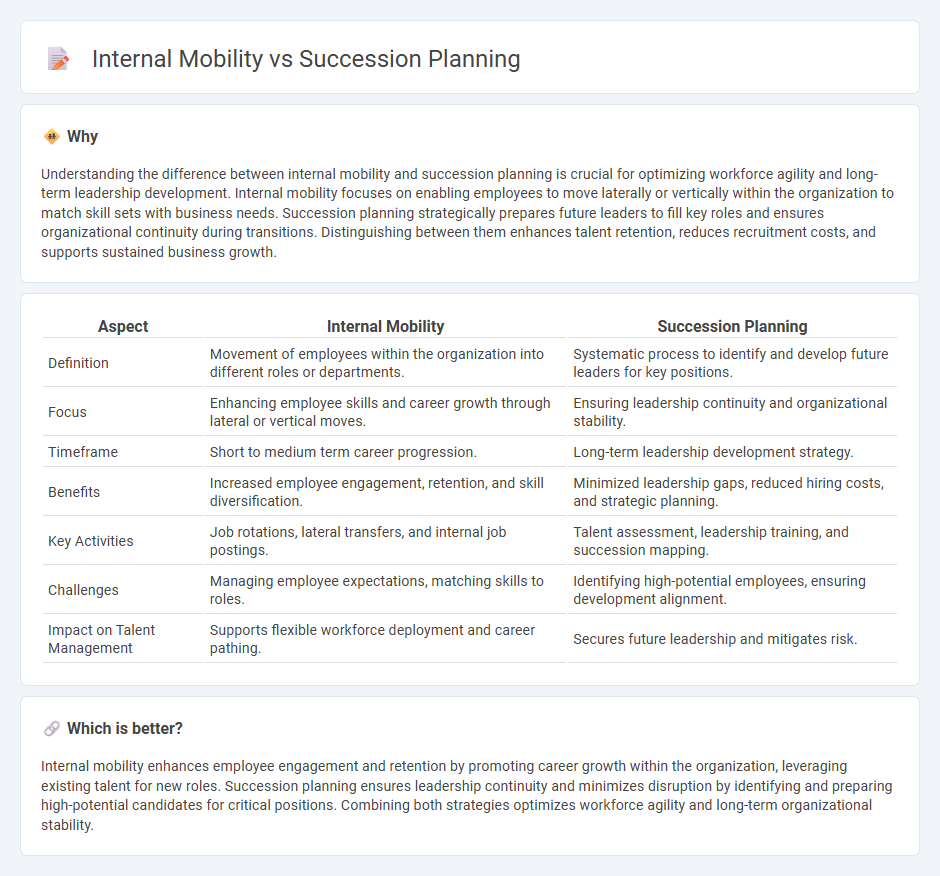
Internal mobility enhances workforce agility by allowing employees to transition into new roles within the organization, promoting skill development and retention. Succession planning strategically identifies and prepares high-potential talent to fill key leadership positions, ensuring business continuity. Explore more about how these strategies drive organizational growth and stability.
Why it is important
Understanding the difference between internal mobility and succession planning is crucial for optimizing workforce agility and long-term leadership development. Internal mobility focuses on enabling employees to move laterally or vertically within the organization to match skill sets with business needs. Succession planning strategically prepares future leaders to fill key roles and ensures organizational continuity during transitions. Distinguishing between them enhances talent retention, reduces recruitment costs, and supports sustained business growth.
Comparison Table
| Aspect | Internal Mobility | Succession Planning |
|---|---|---|
| Definition | Movement of employees within the organization into different roles or departments. | Systematic process to identify and develop future leaders for key positions. |
| Focus | Enhancing employee skills and career growth through lateral or vertical moves. | Ensuring leadership continuity and organizational stability. |
| Timeframe | Short to medium term career progression. | Long-term leadership development strategy. |
| Benefits | Increased employee engagement, retention, and skill diversification. | Minimized leadership gaps, reduced hiring costs, and strategic planning. |
| Key Activities | Job rotations, lateral transfers, and internal job postings. | Talent assessment, leadership training, and succession mapping. |
| Challenges | Managing employee expectations, matching skills to roles. | Identifying high-potential employees, ensuring development alignment. |
| Impact on Talent Management | Supports flexible workforce deployment and career pathing. | Secures future leadership and mitigates risk. |
Which is better?
Internal mobility enhances employee engagement and retention by promoting career growth within the organization, leveraging existing talent for new roles. Succession planning ensures leadership continuity and minimizes disruption by identifying and preparing high-potential candidates for critical positions. Combining both strategies optimizes workforce agility and long-term organizational stability.
Connection
Internal mobility enhances talent retention by providing employees with growth opportunities, which directly supports effective succession planning by creating a pool of qualified candidates for key positions. Succession planning relies on internal mobility data to identify high-potential employees ready for leadership roles, ensuring a smooth transition in critical job functions. Integrating both strategies boosts organizational resilience and aligns workforce development with long-term business goals.
Key Terms
Leadership Pipeline
Succession planning strategically identifies and develops high-potential leaders to fill critical roles, ensuring business continuity and leadership pipeline strength. Internal mobility promotes the dynamic movement of talent within the organization, fostering skill diversification and employee engagement that enriches leadership readiness. Explore effective strategies for integrating succession planning with internal mobility to build a robust leadership pipeline.
Talent Development
Succession planning targets identifying and preparing high-potential employees for critical leadership roles, ensuring organizational stability and long-term growth. Internal mobility emphasizes the movement of talent across various roles and departments to enhance skill sets, employee engagement, and retention. Explore comprehensive strategies to integrate succession planning with internal mobility for optimal talent development outcomes.
Career Pathways
Succession planning focuses on identifying and preparing high-potential employees for key leadership roles to ensure organizational stability, while internal mobility emphasizes the broader movement of employees across various departments and roles to foster skills development and retention. Career pathways serve as a strategic framework linking both concepts by mapping clear, structured opportunities for growth and advancement within the organization. Explore how integrating succession planning with internal mobility through defined career pathways can drive talent development and business success.
Source and External Links
Succession Planning: All You Need To Know [2025 Edition] - This resource provides a comprehensive guide to succession planning, including a step-by-step model for identifying and developing key talent.
Succession Planning: 7-Step Guide & Template - Offers a structured approach to succession planning with seven steps, focusing on transparency and collaboration.
Succession planning - Wikipedia - Explains the process and strategy for replacement planning, used in various contexts to ensure continuity by identifying and developing future leaders.
 dowidth.com
dowidth.com